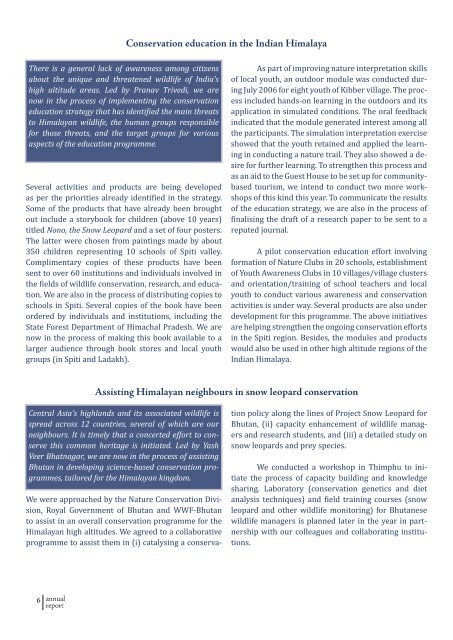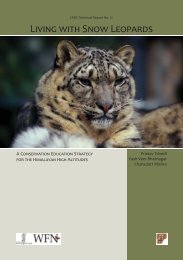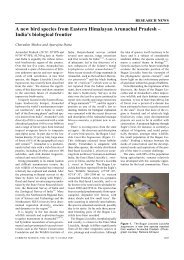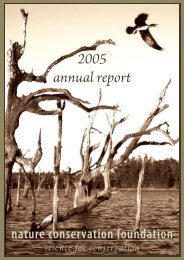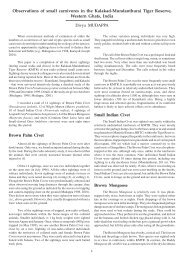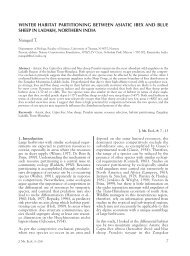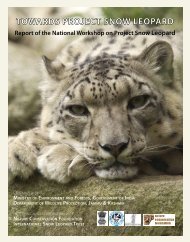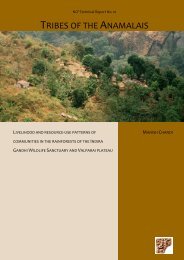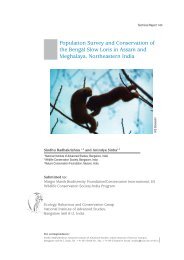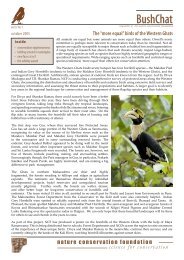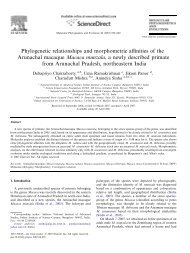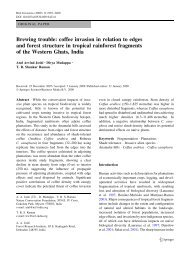2006-7 annual report - Nature Conservation Foundation
2006-7 annual report - Nature Conservation Foundation
2006-7 annual report - Nature Conservation Foundation
Create successful ePaper yourself
Turn your PDF publications into a flip-book with our unique Google optimized e-Paper software.
<strong>Conservation</strong> education in the Indian Himalaya<br />
There is a general lack of awareness among citizens<br />
about the unique and threatened wildlife of India’s<br />
high altitude areas. Led by Pranav Trivedi, we are<br />
now in the process of implementing the conservation<br />
education strategy that has identified the main threats<br />
to Himalayan wildlife, the human groups responsible<br />
for those threats, and the target groups for various<br />
aspects of the education programme.<br />
Several activities and products are being developed<br />
as per the priorities already identified in the strategy.<br />
Some of the products that have already been brought<br />
out include a storybook for children (above 10 years)<br />
titled Nono, the Snow Leopard and a set of four posters.<br />
The latter were chosen from paintings made by about<br />
350 children representing 10 schools of Spiti valley.<br />
Complimentary copies of these products have been<br />
sent to over 60 institutions and individuals involved in<br />
the fields of wildlife conservation, research, and education.<br />
We are also in the process of distributing copies to<br />
schools in Spiti. Several copies of the book have been<br />
ordered by individuals and institutions, including the<br />
State Forest Department of Himachal Pradesh. We are<br />
now in the process of making this book available to a<br />
larger audience through book stores and local youth<br />
groups (in Spiti and Ladakh).<br />
As part of improving nature interpretation skills<br />
of local youth, an outdoor module was conducted during<br />
July <strong>2006</strong> for eight youth of Kibber village. The process<br />
included hands-on learning in the outdoors and its<br />
application in simulated conditions. The oral feedback<br />
indicated that the module generated interest among all<br />
the participants. The simulation interpretation exercise<br />
showed that the youth retained and applied the learning<br />
in conducting a nature trail. They also showed a desire<br />
for further learning. To strengthen this process and<br />
as an aid to the Guest House to be set up for communitybased<br />
tourism, we intend to conduct two more workshops<br />
of this kind this year. To communicate the results<br />
of the education strategy, we are also in the process of<br />
finalising the draft of a research paper to be sent to a<br />
reputed journal.<br />
A pilot conservation education effort involving<br />
formation of <strong>Nature</strong> Clubs in 20 schools, establishment<br />
of Youth Awareness Clubs in 10 villages/village clusters<br />
and orientation/training of school teachers and local<br />
youth to conduct various awareness and conservation<br />
activities is under way. Several products are also under<br />
development for this programme. The above initiatives<br />
are helping strengthen the ongoing conservation efforts<br />
in the Spiti region. Besides, the modules and products<br />
would also be used in other high altitude regions of the<br />
Indian Himalaya.<br />
Assisting Himalayan neighbours in snow leopard conservation<br />
Central Asia’s highlands and its associated wildlife is<br />
spread across 12 countries, several of which are our<br />
neighbours. It is timely that a concerted effort to conserve<br />
this common heritage is initiated. Led by Yash<br />
Veer Bhatnagar, we are now in the process of assisting<br />
Bhutan in developing science-based conservation programmes,<br />
tailored for the Himalayan kingdom.<br />
We were approached by the <strong>Nature</strong> <strong>Conservation</strong> Division,<br />
Royal Government of Bhutan and WWF-Bhutan<br />
to assist in an overall conservation programme for the<br />
Himalayan high altitudes. We agreed to a collaborative<br />
programme to assist them in (i) catalysing a conserva-<br />
tion policy along the lines of Project Snow Leopard for<br />
Bhutan, (ii) capacity enhancement of wildlife managers<br />
and research students, and (iii) a detailed study on<br />
snow leopards and prey species.<br />
We conducted a workshop in Thimphu to initiate<br />
the process of capacity building and knowledge<br />
sharing. Laboratory (conservation genetics and diet<br />
analysis techniques) and field training courses (snow<br />
leopard and other wildlife monitoring) for Bhutanese<br />
wildlife managers is planned later in the year in partnership<br />
with our colleagues and collaborating institutions.<br />
6<br />
<strong>annual</strong><br />
<strong>report</strong>


